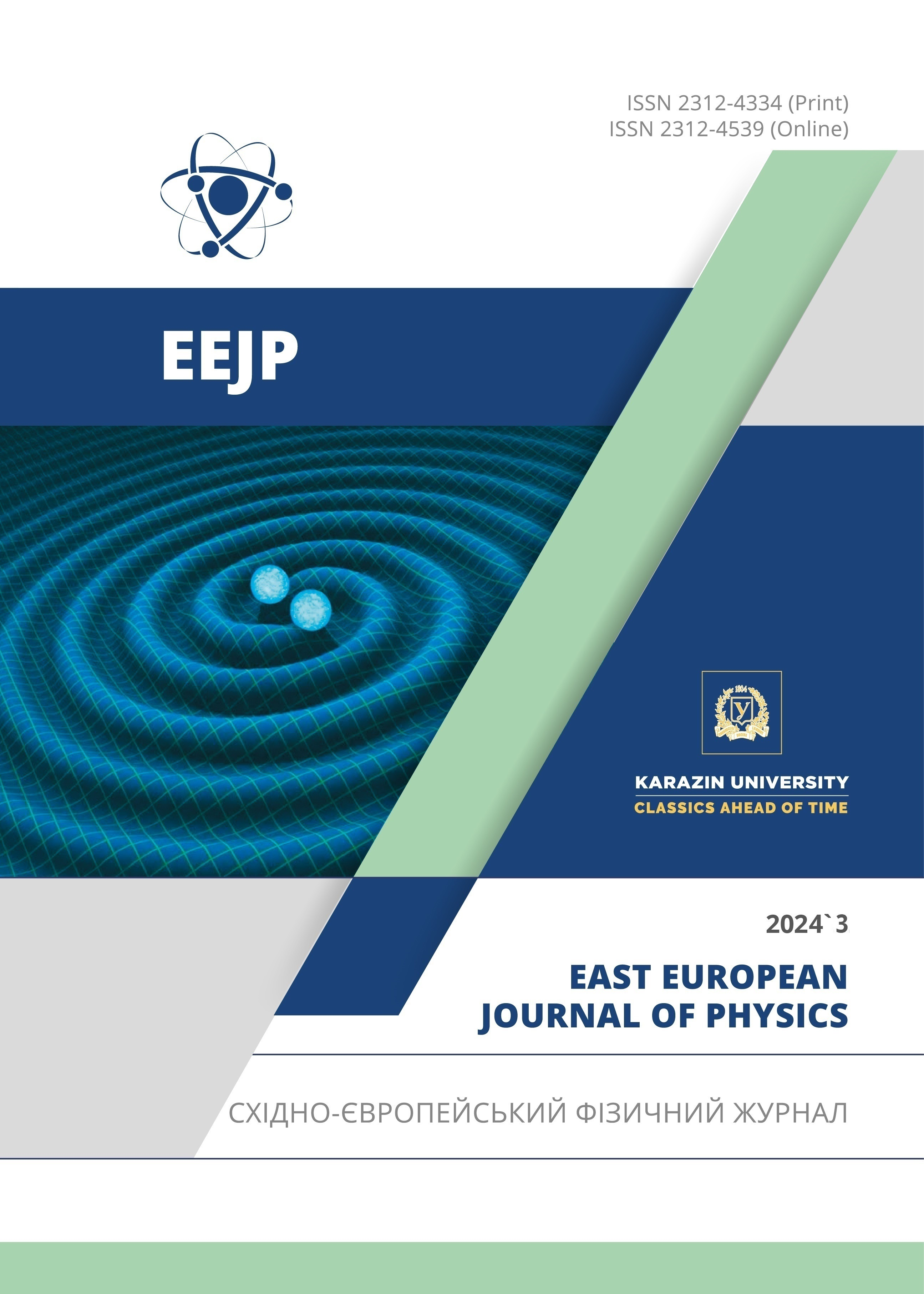Модель гравітації Біанчі типу-I f(T) з темною енергією pilgrim
Анотація
У цій роботі ми проаналізували простір-час Б’янкі типу I (просторово однорідний та анізотропний), використовуючи дві взаємодіючі рідини – темну матерію (DM) і темну енергію Pilgrim (PDE) в рамках f(T) гравітації, враховуючи інфрачервоне (ІЧ) відсікання як кандидата на горизонт Хаббла L=1/H. Ми також провели діагностику за допомогою шукача стану, а також обговорили енергетичні умови для перевірки прискореного розширення Всесвіту.
Завантаження
Посилання
S. Perlmutter, et al., Astrophys J. 517(2), 565–586 (1999). https://doi.org/10.1086/307221
R.A. Knop, et al., Astrophys J. 598(1), 102–137 (2003). https://doi.org/10.1086/378560
G. Hinshaw, et al., Astrophys. J. Suppl. Ser. 208(2), 19 (2013). https://doi.org/10.1088/0067-0049/208/2/19
K.S. Wankhade, A.Y. Shaikh, and S. N. Khan, East European J. of Phys. 2023(3), 87–95 (2023). https://doi.org/10.26565/2312-4334-2023-3-06
A.S. Agrawal, S.K. Tripathy, and B. Mishra, Chin. J. of Phys. 71, 333–340 (2021). https://doi.org/10.1016/J.CJPH.2021.03.004
P. K. Sahoo, and S. Bhattacharjee, New Astronomy, 77, 101351 (2020). https://doi.org/10.1016/j.newast.2019.101351
S. D. Katore, and R. J. Baxi, Ind. J. of Phys. 93(11), 1501–1514 (2019). https://doi.org/10.1007/s12648-019-01411-z
S. Nojiri, S.D. Odintsov, and V.K. Oikonomou, Ann. Phys. 418, (2020). https://doi.org/10.1016/j.aop.2020.168186
A. Pradhan, G. Goswami, and A. Beesham, Int. J. of Geom. Meth. in Mod. Phys. 20(10), (2023). https://doi.org/10.1142/S0219887823501694
C.P. Singh, and A. Kumar, Grav. and Cosm. 25(1), 58–68 (2019). https://doi.org/10.1134/S0202289319010109
A.Y. Shaikh, and K S. Wankhade, Theor. Phys, 2(1), (2017). https://doi.org/10.22606/tp.2017.21006
V.J. Dagwal, D.D. Pawar, and Y.S. Solanke, Mod. Phys. Lett. A, 35(38), 2050316 (2020). https://doi.org/10.1142/S0217732320503162
R. Ferraro, and F. Fiorini, Phys. Rev. D, 75(8), 084031 (2007). https://doi.org/10.1103/PhysRevD.75.084031
Y.-F. Cai, S. Capozziello, M. de Laurentis, and E.N. Saridakis, Rep. Prog. Phys. 79(10), 106901 (2016). https://doi.org/10.1088/0034-4885/79/10/106901
M. Zubair, and S. Waheed, Astrophys. Space Sci. 355(2), 361 (2015). https://doi.org/10.1007/s10509-014-2181-7
K. Karami, and A. Abdolmaleki, J. of Cosm. and Astropart. Phys. 4, 007 (2012). https://doi.org/10.1088/1475-7516/2012/04/007
M. Jamil, D. Momeni, and R. Myrzakulov, Eur. Phys. J. C, 72(8), 1 (2012) https://doi.org/10.1140/epjc/s10052-012-2122-y
M.Z. ul H. Bhatti, Z. Yousaf, and S. Hanif, Physics of the Dark Universe, 16, 34 (2017). https://doi.org/10.1016/j.dark.2017.04.003
V.J. Dagwal, and D.D. Pawar, Mod. Phys. Lett. A, 35 (4), (2020). https://doi.org/10.1142/S0217732319503577
S. Karimzadeh, and R. Shojaee, Adv. High Energy Phys. 2019, 4026856 (2019). https://doi.org/10.1155/2019/4026856
V.R. Chirde, and S.H. Shekh, Ind. J. of Phys. 92(11), 1485 (2018). https://doi.org/10.1007/s12648-018-1236-y
S.R. Bhoyar, V.R. Chirde, and S.H. Shekh, Astrophys. 60(2), 259 (2017). https://doi.org/10.1007/s10511-017-9480-y
S.H. Shekh, and V.R. Chirde, Astrophys. Space Sci. 365(3), 1 (2020). https://doi.org/10.1007/s10509-020-03772-y
A.Y. Shaikh, A.S. Shaikh, and K.S. Wankhade, arXiv:2006.12300 [gr-qc], (2020). http://arxiv.org/abs/2006.12300
S. Mandal, and P.K. Sahoo, Mod. Phys. Lett. A, 35(40), 2050328 (2020). https://doi.org/10.1142/S0217732320503289
H. Wei, Class. Quantum Grav. 29(17), 175008 (2012). https://doi.org/10.1088/0264-9381/29/17/175008
M. Sharif, and S. Rani, J. Exp. Theor. Phys. 119(1), 75 (2014). https://doi.org/10.1134/S1063776114070152
M. Sharif, and M. Zubair, Astrophys. Space Sci. 352(1), 263 (2014). https://doi.org/10.1007/s10509-014-1889-8
A. Jawad, S. Rani, I.G. Salako, and F. Gulshan, Int. J. Mod. Phys. D, 26(06), 1750049 (2017). https://doi.org/10.1142/S0218271817500493
M. Sharif, and K. Nazir, Astrophys. Space Sci. 360(57), 1 (2015). https://doi.org/10.1007/S10509-015-2572-4
A. Jawad, and S. Rani, Adv. High Energy Phys. 2015, 952156 (2015). https://doi.org/10.1155/2015/952156
N. Myrzakulov, S.H. Shekh, A. Mussatayeva, and M. Koussour, Front. in Astr. Space Sci. 9, 105 (2022). https://doi.org/10.3389/fspas.2022.902552
H. Wei, and R.G. Cai, Eur. Phys. J. C, 59(1), 99 (2009). https://doi.org/10.1140/epjc/s10052-008-0799-8
M.S. Berman, Il Nuovo Cimento B, 74(2), 182 (2007). https://doi.org/10.1007/BF02721676
A.Y. Shaikh, Bulg. J. Phys. 49(2), 190 (2022). https://doi.org/10.55318/bgjp.2022.49.2.190
M.R. Setare, and E.N. Saridakis, Phys. Rev. D, 79(4), 043005 (2009). https://doi.org/10.1103/PhysRevD.79.043005
V. Sahni, T.D. Saini, A.A. Starobinsky, and U. Alam, J. of Exp. Theor. Phys. Lett. 77(5), 201 (2003). https://doi.org/10.1134/1.1574831
A. Raychaudhuri, Phys. Rev. 98(4), 1123 (1955). https://doi.org/10.1103/PhysRev.98.1123
J. Ehlers, Int. J. Mod. Phys. D, 15(10), 1573 (2006). https://doi.org/10.1142/S0218271806008966
S. Nojiri, and S.D. Odintsov, Int. J. Geom. Meth. Mod. Phys. 4(1), 115 (2007). https://doi.org/10.1142/S0219887807001928
V.R. Patil, P.A. Bolke, S.K. Waghmare, and J.L. Pawde, East European J. of Phys. (3), 53 (2023). https://doi.org/10.26565/2312-4334-2023-3-03
K.S. Wankhade, A.Y. Shaikh, and S.N. Khan, Prespacetime J. 13(3), 365–379 (2022). https://www.prespacetime.com/index.php/pst/article/view/1852
Авторське право (c) 2024 Сірадж Н. Хан, Кішор С. Ванкхаде, Альфред Ю. Шейх

Цю роботу ліцензовано за Міжнародня ліцензія Creative Commons Attribution 4.0.
Автори, які публікуються у цьому журналі, погоджуються з наступними умовами:
- Автори залишають за собою право на авторство своєї роботи та передають журналу право першої публікації цієї роботи на умовах ліцензії Creative Commons Attribution License, котра дозволяє іншим особам вільно розповсюджувати опубліковану роботу з обов'язковим посиланням на авторів оригінальної роботи та першу публікацію роботи у цьому журналі.
- Автори мають право укладати самостійні додаткові угоди щодо неексклюзивного розповсюдження роботи у тому вигляді, в якому вона була опублікована цим журналом (наприклад, розміщувати роботу в електронному сховищі установи або публікувати у складі монографії), за умови збереження посилання на першу публікацію роботи у цьому журналі.
- Політика журналу дозволяє і заохочує розміщення авторами в мережі Інтернет (наприклад, у сховищах установ або на особистих веб-сайтах) рукопису роботи, як до подання цього рукопису до редакції, так і під час його редакційного опрацювання, оскільки це сприяє виникненню продуктивної наукової дискусії та позитивно позначається на оперативності та динаміці цитування опублікованої роботи (див. The Effect of Open Access).








